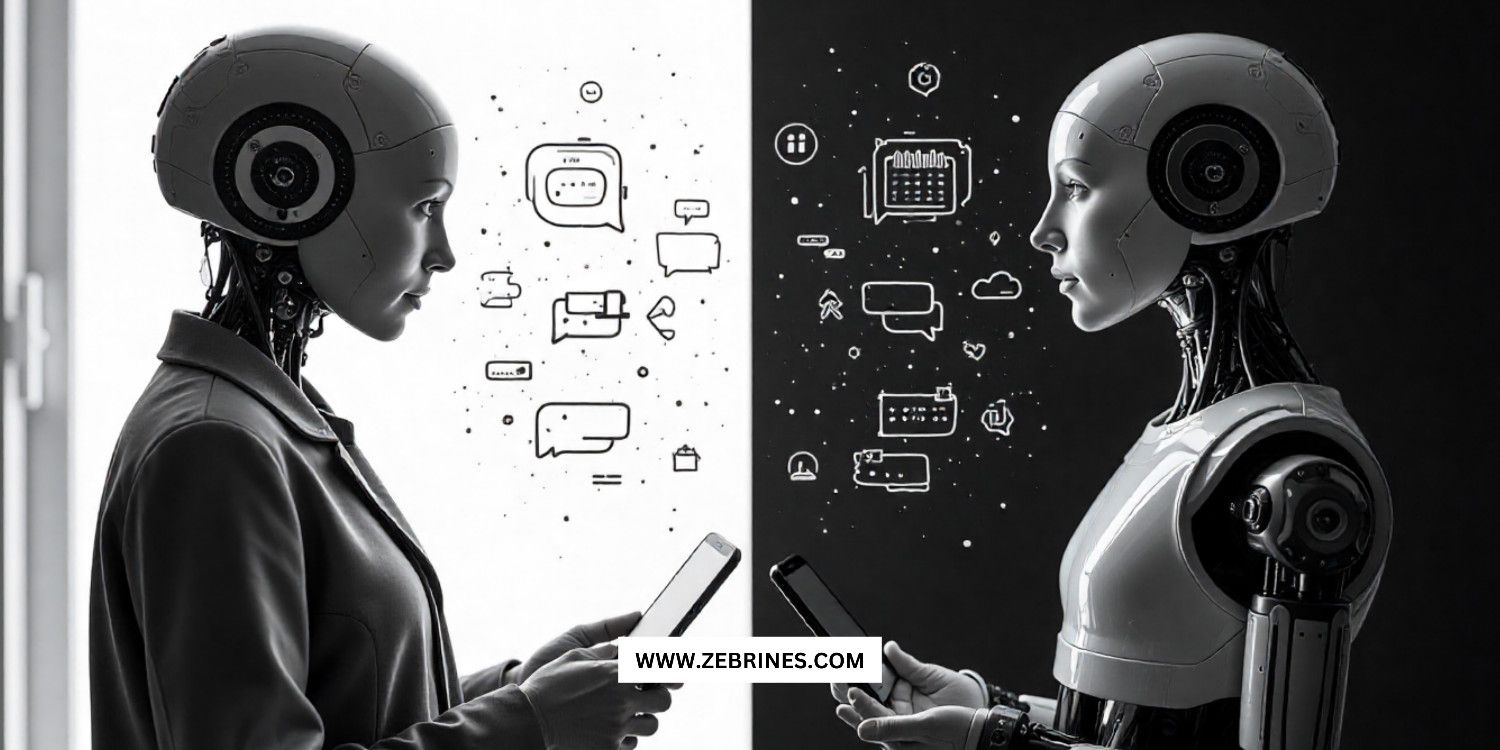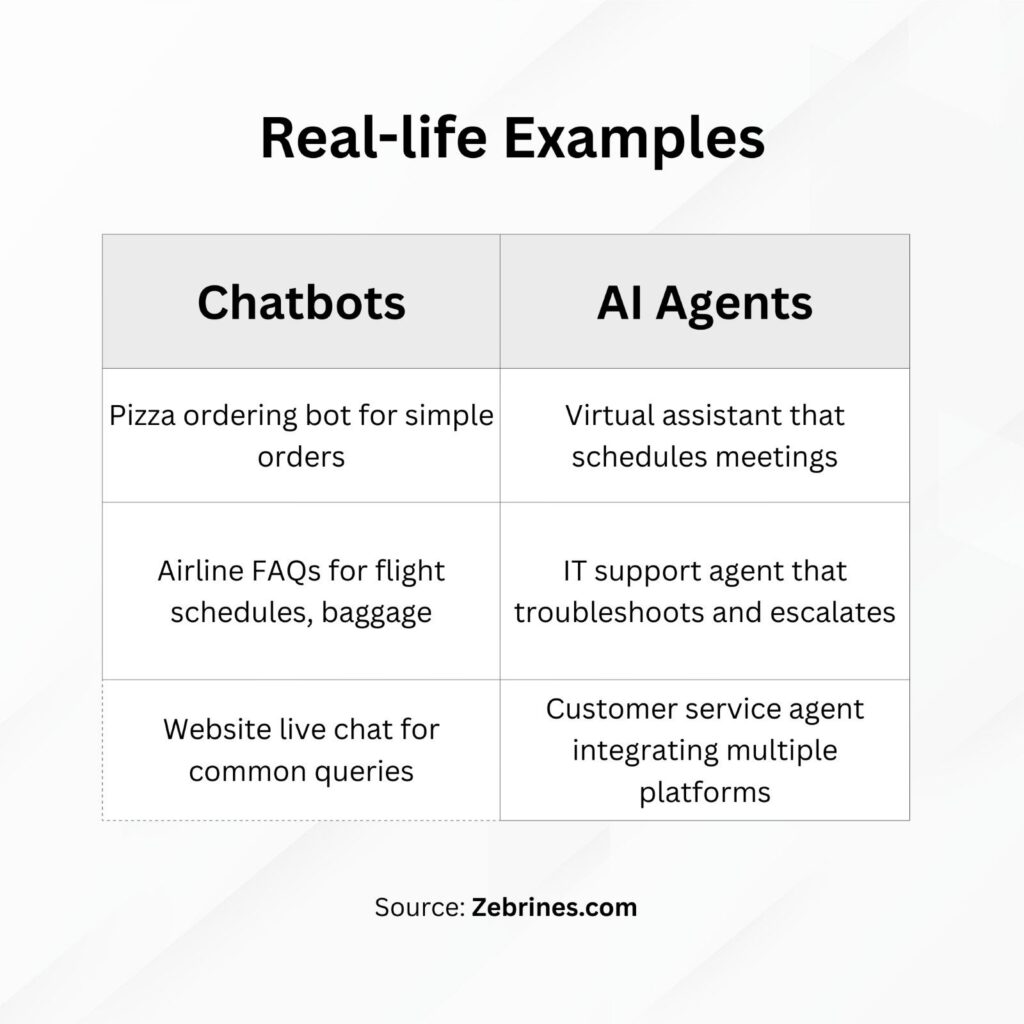
Introduction
It’s hard to understand the difference between AI agents and chatbots. Both use artificial intelligence, but they work in very different ways. Chatbots handle simple, scripted conversations, like answering FAQs or helping customers on a website.
AI agents are more advanced—they can complete multi-step tasks, connect with different systems, and make independent decisions. Knowing the difference helps businesses choose the right tool, save time, improve efficiency, and give customers a better experience.
Learn more about What are AI Agents
Chatbots Explained: Why Simple Conversations Aren’t Always Enough
Chatbots are AI tools that follow a set of rules to talk with users. They work best for simple tasks like answering common questions, tracking orders, or guiding visitors on a website. Using Natural Language Processing (NLP), chatbots can understand basic queries, but they usually cannot handle complex tasks or remember long-term information.
Advantages of Chatbots:
- Quick to deploy and easy to set up
- Cost-effective for repetitive tasks
- Ideal for answering FAQs, tracking orders, or guiding users on a website
Limitations of Chatbots:
- Struggle with questions outside their predefined script
- Cannot perform complex or multi-step actions
- Lack long-term memory and personalization
For small businesses or websites with high-volume, predictable queries, chatbots are an excellent choice. However, they cannot replace the broader capabilities of AI agents, which can handle more advanced tasks and provide personalized experiences.
AI Agents Demystified: How They Do More Than Just Chat
AI agents are smart systems that can work on their own. Unlike chatbots, they can remember user preferences, handle several tasks at once, and act without waiting for instructions.
What AI Agents Can Do:
- Work independently and make decisions
- Learn and get better over time
- Connect with apps, tools, and platforms
- Give helpful suggestions and insights
Where They Help Most:
- Automating customer support
- Managing schedules, bookings, and reminders
- Helping sales and marketing with data insights
- Monitoring systems and spotting issues early
AI agents need more setup than chatbots, but they save time, improve accuracy, and give better results. For businesses that want smart automation and personalized support, AI agents are the best choice.
Chatbots vs AI Agents: The Side-by-Side Breakdown Everyone Needs
Here’s a clear comparison to help you understand the differences:
| Feature | Chatbots | AI Agents |
|---|---|---|
| Intelligence Level | Rule-based, limited NLP | Advanced LLMs, reasoning |
| Scope | Narrow, predefined flows | Broad, adaptable to new tasks |
| Memory | Short-term or none | Long-term, contextual memory |
| Autonomy | Reactive, needs input | Proactive, initiates actions |
| Integrations | Limited APIs, scripted | Deep system integrations |
| Example Use Case | FAQ support, order tracking | Virtual assistant, workflow automation |
When to Use Chatbots: Why They Still Matter
Chatbots remain valuable for businesses with repetitive or simple customer tasks. They cut costs, lighten staff workloads, and deliver fast responses.
Benefits of Chatbots:
- Deploy quickly and affordably
- Answer FAQs and track orders
- Schedule appointments and support online sales
- Reduce manual handling of routine tasks
Why They Work:
- Fit small businesses with predictable queries
- Require no complex workflows or deep customization
- Serve as a reliable first point of contact
Even as AI agents gain popularity, chatbots still provide practical, low-effort automation for many businesses.
When to Use AI Agents: Why Your Business Needs Them Now
AI agents suit businesses that need automation, personalized support, and multi-step workflows. They handle tasks across multiple systems, retain context, and make proactive decisions.
How AI Agents Drive Business Results:
- Automate IT support, HR onboarding, or order management
- Provide personalised assistance to customers and employees
- Integrate data from multiple platforms for actionable insights
- Adapt to changing workflows and user behaviour
When They Make a Difference:
- Scaling operations without adding staff
- Reducing errors in repetitive or multi-step tasks
- Enhancing decision-making with real-time data
Though AI agents cost more than chatbots, their autonomy, flexibility, and efficiency make them essential for medium to large-sized businesses.
Real-Life Examples: Chatbots vs AI Agents in Action

- Chatbots:
- A pizza ordering bot that takes simple orders.
- Airline FAQs for flight schedules and baggage rules.
- Website live chat for answering common queries.
- AI Agents:
- Virtual assistants that schedule meetings and handle emails.
- IT support agents who troubleshoot and escalate issues.
- Customer service agents who integrate across multiple platforms and provide personalized guidance.
These examples show that chatbots are reactive tools, while AI agents are proactive, intelligent systems.
Future Trends: Will Chatbots Merge Into AI Agents?
The gap between chatbots and AI agents is shrinking. Advanced language models (LLMs) let chatbots gain features like memory, multi-step reasoning, and system integration.
What to Expect:
- Lightweight AI agents handle routine tasks automatically
- Chatbots evolve into hybrid systems managing simple and moderately complex workflows
- Businesses benefit from flexible, intelligent automation across platforms
This shift signals a future where AI systems combine efficiency with adaptability, making both chatbots and agents more capable.
Conclusion: Pick the Right Tool Without Guesswork
Knowing the difference between AI agents and chatbots helps you choose the right technology. Use chatbots for simple, cost-effective automation. Use AI agents for complex tasks, personalised support, and proactive workflows.
Key Takeaways:
- Chatbots handle routine tasks quickly and cheaply
- AI agents manage multi-step processes and adapt to user needs
- Choosing the right tool improves efficiency and customer experience
By matching your business needs to the right solution, you save time, cut costs, and improve productivity.
